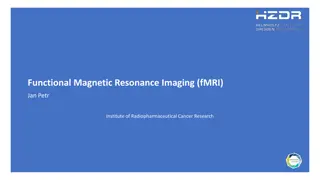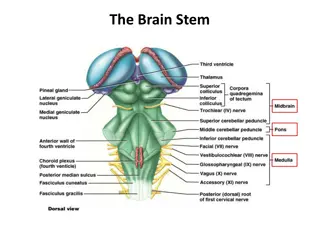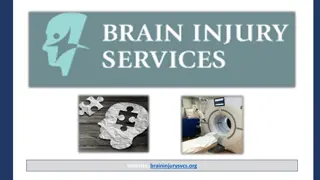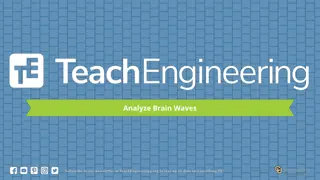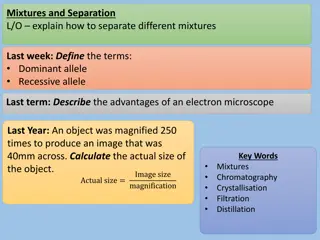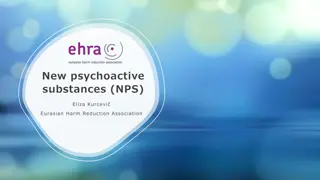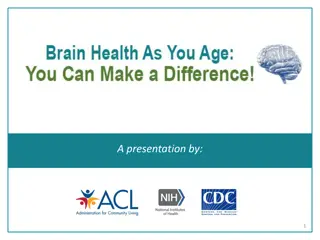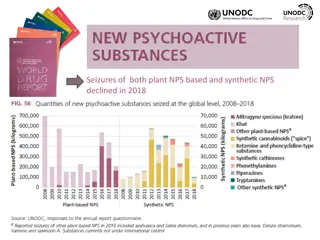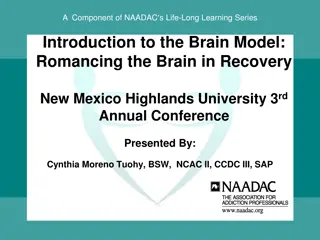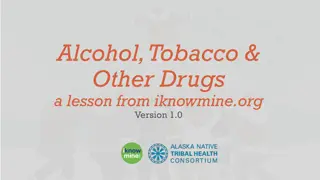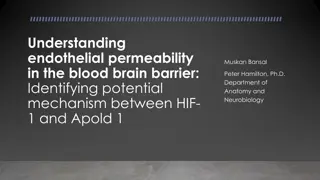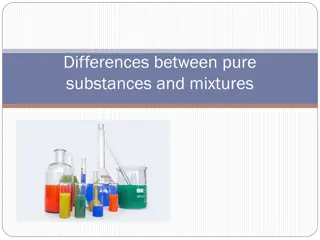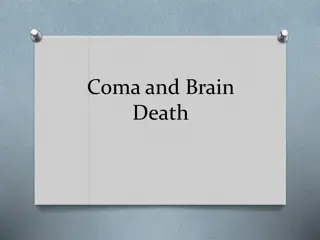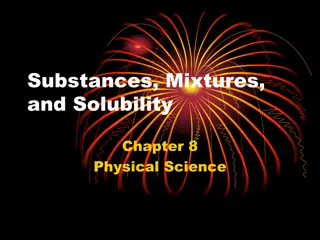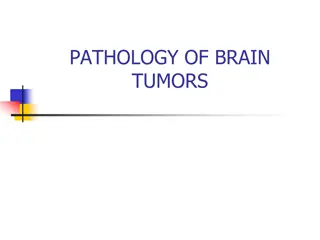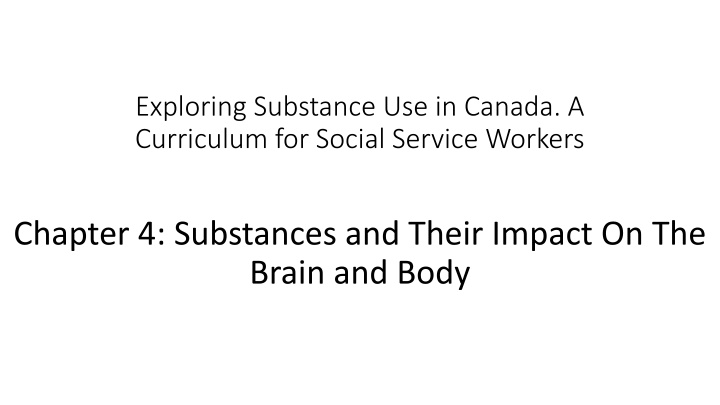
Understanding Substance Use: Effects on Brain and Body
Explore the physiological, psychological, and subjective effects of substance use, along with discussions on multi-substance use and adverse interactions. Learn about how substances impact the human brain, including the brain stem, cerebral cortex, and limbic system.
Download Presentation

Please find below an Image/Link to download the presentation.
The content on the website is provided AS IS for your information and personal use only. It may not be sold, licensed, or shared on other websites without obtaining consent from the author. If you encounter any issues during the download, it is possible that the publisher has removed the file from their server.
You are allowed to download the files provided on this website for personal or commercial use, subject to the condition that they are used lawfully. All files are the property of their respective owners.
The content on the website is provided AS IS for your information and personal use only. It may not be sold, licensed, or shared on other websites without obtaining consent from the author.
E N D
Presentation Transcript
Exploring Substance Use in Canada. A Curriculum for Social Service Workers Chapter 4: Substances and Their Impact On The Brain and Body
Describe the physiological effects of substance use Describe the psychological effects of substance use Describe the subjective effects of substance use Discuss multi-substance use Discuss adverse substance interactions Learning Objectives:
The Human Brain The human brain weighs three pounds The brain regulates your body s basic functions The brain enables you to interpret and respond to everything you experience The brain shapes your thoughts, emotions, and behavior. Different parts of the brain are responsible for coordinating and performing specific functions Substances can alter important brain sections necessary for life- sustaining functions and can drive addiction
The Human Brain This Photo by Unknown Author is licensed under CC BY-SA-NC
The Human Brain: Major Structures and Functions https://youtu.be/0-8PvNOdByc (NIDA, 2016).
The Brain Stem The brain stem The brain stem controls basic functions critical to life, such as heart rate, breathing, and sleeping. This Photo by Unknown Author is licensed under CC BY-NC
The Cerebral Cortex The cerebral cortex The cerebral cortex, which is divided into areas that control specific functions. Different areas process information from our senses, enabling us to see, feel, hear, and taste. The front part of the cortex, the frontal cortex or forebrain, is the thinking center of the brain; it powers our ability to think, plan, solve problems, and make decisions.
The Limbic System The limbic systemcontains the brain s reward circuit. It links together a number of brain structures that control and regulate our ability to feel pleasure. Feeling pleasure motivates us to repeat behaviors that are critical to our existence. The limbic system is activated by healthy, life-sustaining activities such as eating and socializing but it is also activated by use and misuse of substances. In addition, the limbic system is responsible for our perception of other emotions, both positive and negative, which explains the mood-altering properties of many substances. This Photo by Unknown Author is licensed under CC BY-NC-ND
How do the parts of the brain communicate? These nerve networks coordinate and regulate everything we feel, think, and do. Neuron to Neuron Each nerve cell in the brain sends and receives messages in the form of electrical and chemical signals. Once a cell receives and processes a message, it sends it on to other neurons. Neurotransmitters The brain s chemical messengers The messages are typically carried between neurons by chemicals called neurotransmitters. Receptors brain s chemical receivers- The neurotransmitter attaches to a specialized site on the receiving neuron called a receptor. A neurotransmitter and its receptor operate like a key and lock, an exquisitely specific mechanism that ensures that each receptor will forward the appropriate message only after interacting with the right kind of neurotransmitter. Transporters The brain s chemical recyclers Located on the neuron that releases the neurotransmitter, transporters recycle these neurotransmitters (that is, bring them back into the neuron that released them), thereby shutting off the signal between neurons.
The Nervous System in 9 Minutes https://youtu.be/44B0ms3XPKU (CTE Skills, 2017).
The Nervous System Part 1: Crash Course Anatomy https://youtu.be/qPix_X-9t7E (Crash Course, 2015).
The faster a substance reaches the brain, the more likely it may become misused. The faster a substance reaches the brain, the more likely it may become misused. Different methods of delivery smoking, injecting, or snorting largely influence how quickly a substance reaches the brain. Delivery methods, genetics, and environment all influence the potential of a substance to develop into a substance use disorder This Photo by Unknown Author is licensed under CC BY-SA-NC
Route buccal Explanation held inside the cheek Administration of Substances into the body enteral delivered directly into the stomach or intestine (with a G-tube or J-tube) inhalable breathed in through a tube or mask infused injected into a vein with an IV line and slowly dripped in over time intramuscular injected into muscle with a syringe intrathecal injected into your spine intravenous injected into a vein or into an IV line nasal given into the nose by spray or pump ophthalmic given into the eye by drops, gel, or ointment oral swallowed by mouth as a tablet, capsule, lozenge, or liquid otic rectal given by drops into the ear inserted into the rectum subcutaneous injected just under the skin sublingual topical held under the tongue applied to the skin transdermal vaginal given through a patch placed on the skin inserted into the vagina (Merck Manuals, 2021)
Time Needed for Effect Disadvantages of Route Method Example of Drug Advantages of Route Oral Alcohol 30-60 minutes Convenient Slow, irregular Inhalation Nicotine 8 seconds Fast Lung damage Intravenous Injection Heroin 15 seconds Fast Overdose/ infections Mucous membrane Cocaine 1-2 minutes Convenient Local tissue damage Subcutaneous injection Heroin 5-10 minutes Safer & easier than IV Infection Intramuscular Injection Morphine 10-15 minutes Controlled Painful Limited application/ potential misuse Transdermal Nicotine 15-20 minutes Convenient (Case-Lo, 2019).
Rapid Delivery Changes Your Brain People who have a substance use disorder often choose a delivery method that gets them high quickly. As the SUD progresses, people will seek out the more immediate and more intense high. Rapid delivery, such as smoking, affects brain regions that facilitate substance use disorders.
Slow Delivery Delivering a substance slowly, by ingestion or through the skin, produces a weaker, longer-lasting effect. Slow delivery allows the substance to temporarily stabilize the brain and help reduce withdrawal symptoms over a longer period of time. Research suggests a slower delivery method can reduce the risk of an addiction. (Genetic Science Learning Center, 2013). This Photo by Unknown Author is licensed under CC BY-NC
Depressants Reduce central nervous system activity. Depressants serve as agonists of the Gamma-Aminobutyric Acid (GABA) neurotransmitter system. Because GABA has a quieting effect on the brain, GABA agonists also have a quieting effect; these types of substances are often prescribed to treat both anxiety and insomnia. Physical dependence to depressants, particularly alcohol can be life threatening. Withdrawal management is done in a medical facility under the supervision of health care providers.
Stimulants Increase overall levels of neural activity. Many of these substances act as agonists of the dopamine neurotransmitter system. Dopamine activity is often associated with reward and craving; therefore, substances that affect dopamine neurotransmission can be misused. Stimulants like cocaine, amphetamine and MDMA create a euphoric high, feelings of intense elation and pleasure, especially in those who take the substance via intravenous injection or smoking.
Nicotine Associated with increased risks of heart disease, stroke, and a variety of cancers. Nicotine exerts its effects through its interaction with acetylcholine receptors. Acetylcholine functions as a neurotransmitter in motor neurons. In the central nervous system, it plays a role in arousal and reward mechanisms. Nicotine is most commonly used in the form of tobacco products like cigarettes or chewing tobacco; therefore, there is a tremendous interest in developing effective smoking cessation techniques. People have used a variety of nicotine replacement therapies in addition to various psychotherapeutic options in an attempt to discontinue their use of tobacco products.
This Is What Happens To Your Brain On Opioids https://youtu.be/NDVV_M__CSI (National Geographic, 2017).
Opioids Include substances such as heroin, morphine, methadone, and codeine. Opioids have analgesic properties; they decrease pain. Humans have an endogenous opioid neurotransmitter system the body makes small quantities of opioid compounds that bind to opioid receptors reducing pain and producing euphoria. Thus, opioids mimic this endogenous painkilling mechanism. There are both natural opiates, opium, which is a naturally occurring compound found in the poppy plant and synthetic versions of opiates that have very potent painkilling effects. These are the substances, like fentanyl, that you may hear in the news.
Your Brain on LSD and Other Hallucinogens https://youtu.be/Kr0WU-6J79k (Brief Brain Snacks, 2019).
Hallucinogens Hallucinogens alter sensory and perceptual experiences. Some people experience vivid visual hallucinations. It is common for these types of substances to cause hallucinations of body sensations (e.g., feeling as if you are a giant or can fly) and a skewed perception of the passage of time. Hallucinogens are incredibly varied in terms of the neurotransmitter systems they affect. Mescaline and LSD are serotonin agonists, and ketamine (an animal anesthetic) act as antagonists of the NMDA glutamate receptor.
Self Care Please watch the video on Community of Practice, and report back next class.
References Brief Brain Snacks. (2019). Your brain on LSD and other hallucinogens. [Video]. Youtube. https://www.youtube.com/watch?v=Kr0WU-6J79k Case-Lo, C. (2019, March 28). Medication administration: Why it s important to take drugs the right way. https://www.healthline.com/health/administration-of-medication CrashCourse. (2015). The nervous system part 1. [Video]. Youtube. https://youtu.be/qPix_X-9t7E CTE Skills. (2017). The nervous system in 9 minutes. [Video]. Youtube. https://youtu.be/44B0ms3XPKU Genetic Science Learning Center. (2013, August 30). Drug delivery methods. https://learn.genetics.utah.edu/content/addiction/delivery/ National Institute on Drug Abuse. (2016). The human brain: Major structures and functions. [Video]. Youtube. https://youtu.be/44B0ms3XPKU National Geographic. (2017). This is what happens to your brain on opioids. [Video]. Youtube. https://www.youtube.com/watch?v=NDVV_M__CSI The Audiopedia. (2017). What is community of practice? What does community of practice mean? Community of practice meaning. [Video]. Youtube. https://www.youtube.com/watch?v=zqJ- b2MJJ2Y

